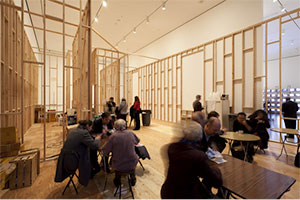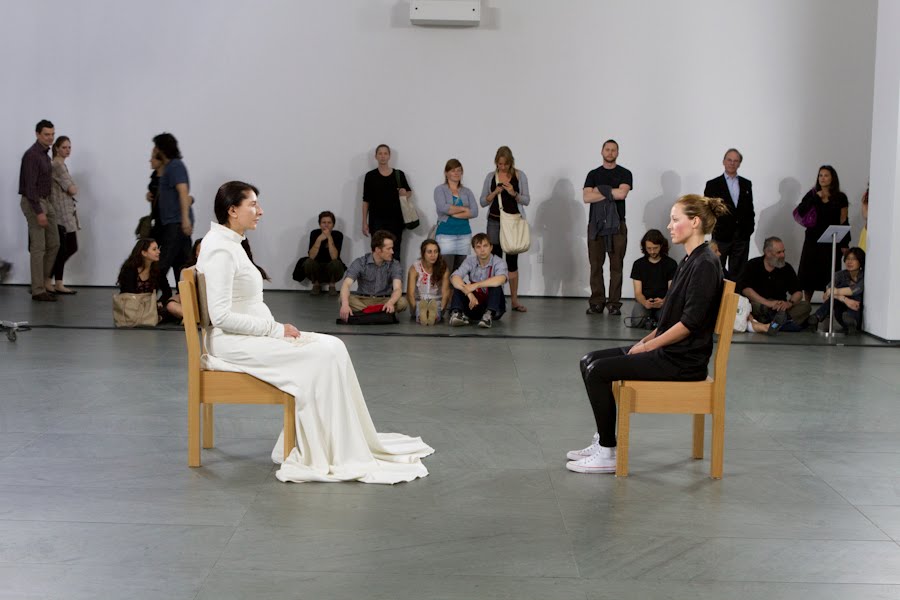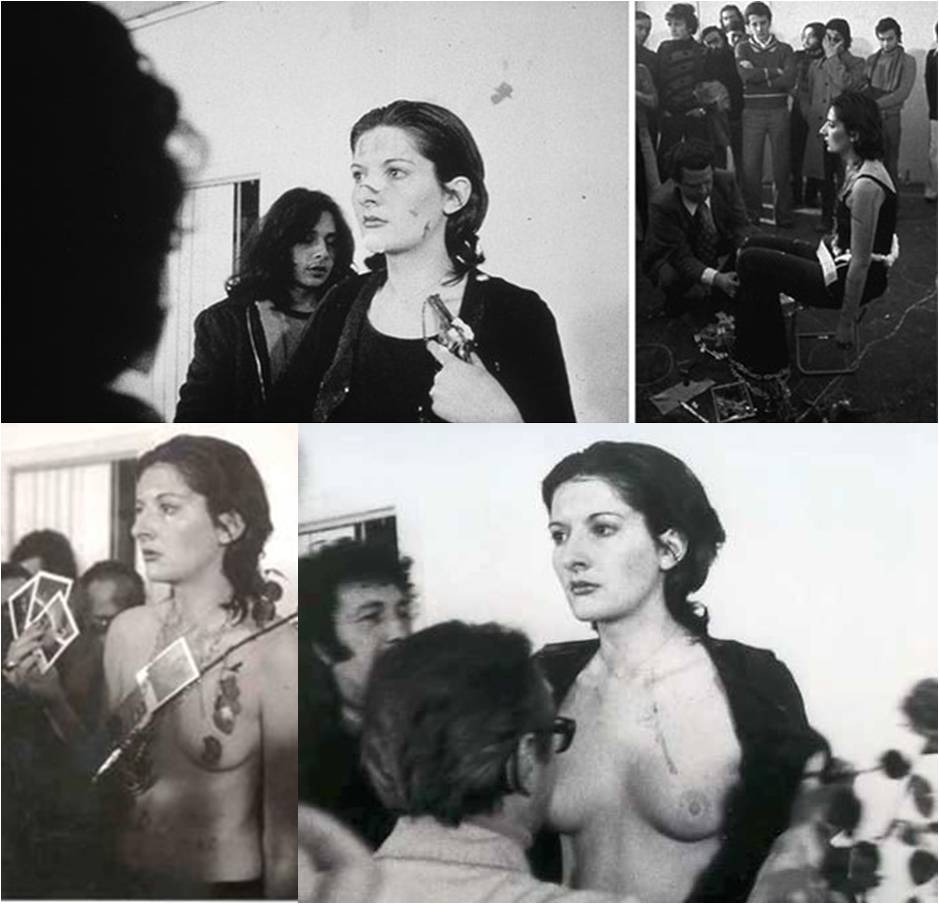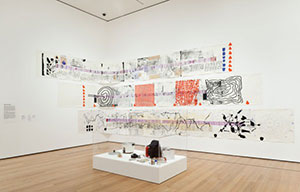Student Name /
Advanced Sculpture, 2014
Project 3: Interactivity
ARTIST RESEARCH
Rirkrit Tiravanija
For Rirkrit Tiravanija, art is social, communal, and highly interactive, and, in some ways, consumable. Influenced by his Thai culture and background, Tiravanija brings viewers and audiences together in art-spaces to partake in a communal dinner involving traditional Thai cuisine as well as other South-east Asian cuisine (Artillery). Tiravanija’s work is heavily based on “interaction and exchange among participants (Wikipedia) as he is concerned with relational aesthetic which is an art movement in which art is the catalyst for social exchange, interaction, and participation among the viewers (The Modern). His intention is to “blur the distance between the artwork and the viewer” as he focuses on “human interactions and bringing people together to share” (The Modern). Tiravanija will either use a space within a museum or exhibition to serve food to the viewer or construct an installation that harbors a kind of social space. In essence, his work can be characterized as created spaces or carefully constructed spaces that mimic communal areas and invite as well as support discussion and dialogue. He will often play music or converse with his viewers as he serves them food, which further contributes to his goal for social aesthetic and the breaking down of limitations for the viewer. These spaces take on simplified forms of dining rooms, kitchens, dinner tables, or dinning and eatery arrangements, bringing in crowds of viewers to enjoy and share a meal cooked and prepared by Tiravanija.
Tiravanijia engages his focus on social aesthetic and communal interaction not only with his cooking installations but also with the construction and exhibition of his installations as well as drawings, paintings, and prints. His sculpture installation piece, Untitled 1992 (Free) and his print piece Untitled 2008-2011 (the map of the land of feeling) I-III, were executed in an approach similar to that of Ai Wei Wei who employs hundreds of laborers to assist him in creating his extensive works.
Tiravanijia’s print Untitled 2008-2011 (the map of the land of feeling) I-III, in particular, involved dozen of laborers to construct a massive 84ft wide by 3ft tall scroll of elaborate inkjet printing, lithography, and screen-printing (Art in America). The project took approximately three years to create and enlisted the assistance of several master printers, forty or more students, and a hand full of shop managers to complete it (Art in America). Due to the commitment of his teaching position at Colombia University, Tiravanijia was also only present at certain points during the production and would leave it in the hands of his assistant Danny Baez to facilitate the process. Yet even in his absence the nature of this extensive project brought together people from different backgrounds and positions to collaborate and create an artwork together which is ultimately the intention of Tiravanijia which is to give hands-on access to participants and fully engage them in the work and interact as they are doing so. Tiravanijia also engages social aesthetics in the exhibition of his work. Exhibitions, in essence, bring audiences together and allow for the viewer to engage in conservation around the work and interact with the artist. Having such large and extensive pieces the sociability of the work because it brings about many viewers and dialogue ensues.
In an interview with Art Review, Tiravanijia talks about the limited access of the public even within the art realm and how the exhibition of art tends to be for the insiders—those who are heavily involved with the arts and arts administration as well as those who are also interested and knowledgeable in the study of art (Art Review). In his sculpture installation and performance Untitled 1992 (Free), Tiravanijia cleared out the office of the 303 Gallery in Soho, NY and constructed and installed a simplified but fully functional kitchen with a fridge, hot plates, rice steamers, tables, and stools (New York Magazine). He then cooked Thai curry for anyone who came by all for free. In performing this act of sharing a meal and sitting down with his audience to partake in a conversation evidences again a kind of sociability of the artwork and breaks down the inaccessibility and limitations of art for the public. In simply building the construction, he enlisted the assistance of other laborers to create this space as well as the many other food-related and social spaces that he went on to construct. The collaborative nature of this project as well as many of his other sculptures, installations, and prints, embodies a notion of Joseph Beuys (in reference to his 7000 oaks) that being the ability of social sculpture to transform society through “human activity with language, thought, action, and objects” (The Modern).
Rirkrit Tiravanija. Untitled 2008–2011 (the map of the land of feeling) I–III. 2008–11.
Screenprint, Lithography, and Inkjet Print.

Rirkrit Tiravanija. Unititled 1992 (Free).Refrigerator, table, chairs, wood,
drywall, food and other materials
Marina Abramovic
Using her body as her subject and an art object, Marina Abramovic explores the relationships between herself as a performance artist and her audience by inviting her audience to take part in the process of art-making within her performances. With her work, Abramovic pushes her body to its limits, engaging in dangerous performances involving weaponry, bows and arrows, and self-mutilation, hypothermic states, and starvation. In doing so, she seeks to find a kind of inner-balance with mind and body and reach self-transformation and transcendence which she describes as “...[testing] the limits of myself in order to transform myself” (The Guardian). Abramovic engages interactivity within her work because her audience is an integral part of her work and without the presence of her audience, she cannot make nor perform art so therefore her art cannot become art until viewed by the public (Times Talks-Youtube). She says "through performance, I found the possibility of establishing a dialogue with the audience through an exchange of energy, which tended to transform the energy itself. I could not produce a single work without the presence of the audience, because the audience gave me the energy to be able, through a specific action, to assimilate it and return it, to create a genuine field of energy" (The Art Story). She engages in exercises involving pain and devoted focus and concentration so that by the end of her performance, it is she, and not just her audience who changes. She seeks to become a new person every time, she engages in long durational performances whether it be by staring into someone’s eyes for many hours or transcending her fears with having a snake wrapped around her. Transcendence for both her and her audience is key and it is definitely an apparent theme in her works as she fully engages interactivity with the viewer in works such as The Artist is Present and Rhythm 0: 1974.
In her performance, The Artist is Present, Abramovic spent a lengthy 736 Hour and 30 minutes in the MoMA, in still silence as she gazed into the eyes of audience members who willingly sat down with her. As she sat motionless, she gazed into the eyes of the viewer and could see “such pain inside that [she] could immediately see it and feel it…[becoming a mirror for them of their own emotions” (The Guardian). In The Artist is Present, Abramovic examines the critical issue of unspoken dialogue and relationships between people that are often times neglected but when realized, these silent and focused relationships become transforming for those who engage in them. Abramovic says that this durational piece, The Artist is Present, definitely transformed her being into something completely different because she spent elongated amounts of time with her audiences, studying them as they studied her, conversing the non-conversable and making it into an art form (New York Times). Abramovic fully engages interactivity in this piece as it is driven solely by audience participation and she is, as transcribed in her goals as an artist, breaking down the barriers between artist or performer and their audience members. She allows the viewers to become the artist as they fully engage themselves within the work by staring deeply into her eyes and allowing themselves to succumb to subdued emotions, inner peace, and eventually, self-discovery and transcendence.
In her work Rhythm 0: 1974, Abramovic engaged in a dangerous performances as she gave full power and creative rights over her own body to her audience members. During this performance, Abramovic laid out 72 objects and the audience was given the freedom to use these objects as they desire onto Abramovic's body. The objects ranged from rose thorns to a loaded gun. Abramovic stood for six hours as the audience members worked on her, at times even manipulating her physically or sexually. At first audiences remained polite and detached, simply tilting her head, moving her arms, placing flower petals on her body, or having her hold something such as a hat or a picture frame. Yet as time passed, the actions became more and more aggressive as some members went as far as stripping her naked, spitting in her face, touching her breasts, cutting her with rose thorns, placing the gun in her hand and forcing her to point it at herself. Afterwards the performance stopped (Harper's Bazaar). In Rhythm 0: 1974, Abramovic tackles the critical issue of pain and complete vulnerability to pain and the power of the viewer in effort to create a kind of spirituality that allows the balance of mind and body. She also explores the effect of the audience on the artist and how critical their role is in the creation and foundation of art--its legitimacy. In an interview with the New York Times, she talks about how one cannot make art if it is a simple conversation--one that is meant only to declare facts. Rather, art is created by an artist and their audience. The audience is the foundation on which art is based and its message, strengthened.

Marina Abramovic performing The Artist Is Present at the Museum of Modern Art, 2010

Marina Abramovic, Rhythm 0, (1974)
Table, 72 objects, slide projection, Modern Galerija, Ljubljiana
Back to Index
This page was last updated:
April 25, 2014 1:15 PM
